Watching the Winter Olympics reminds one of the stamina required to perform at a high level for long events. In reviewing the StarTech DisplayPort KVM switch, I feel like I just completed a marathon, due to the length of time that it took to complete. Read on for impressions of this unique DisplayPort KVM which allows sharing of a DisplayPort monitor and USB mouse and keyboard with two computers.
StarTech graciously lent me a review unit of their DisplayPort KVM switch since late November. Why did it take so long to do a review of it? I’ll get into more detail below, but first, let’s go over the specifications from the press release:
StarTech.com, a leading manufacturer of KVM Switches and Server Management solutions has announced the upcoming release of a DisplayPort KVM Switch (SV231DPU) – the first KVM Switch available with support for direct connections to DisplayPort monitors and computers without using a converter.
The DisplayPort KVM Switch enables users to control two DisplayPort-capable computers using a single keyboard, mouse and monitor while capitalizing on the impressive graphical and audio capability of the DisplayPort interface.
“Current users of DisplayPort technology have had to rely on converting to and from more common interfaces such as DVI and VGA for KVM control of high resolution PCs” commented Jon Arnett, Senior Product Marketing Manager for StarTech.com. “In most cases, that conversion has meant sacrificing the advantages of DisplayPort for the sake of compatibility, as well as adding cost and complexity to the initial setup. The SV231DPU KVM switch supports direct DisplayPort connections, with no compromises”.
The 2-port DisplayPort KVM switch offers a native resolution of 2560 x 1600 (@60 Hz, 30 bpp) as well as 7.1 channel HD digital audio, making it a suitable solution for professional multimedia and high definition content development applications.
DisplayPort supports a maximum bandwidth of 4 lanes at 2.7 Gbps each, which allows for resolutions of up to 3840 x 2400 at reduced refresh rates, ideal for “extreme” resolution applications that require less dynamic graphical capability such as MRI and X-Ray medical imaging and digital signage server control.
Other features of StarTech.com’s SV231DPU include:
- USB 2.0 peripheral sharing
- Hotkey and push-button switching
- Support for Mac and PC operating environments
- DDC2B compliant operation
The SV231DPU KVM Switch is available for pre-order directly from StarTech.com, and will be available for purchase from StarTech.com’s channel partners, including CDW, PC Connection and Insight and will also be distributed by Ingram Micro, Tech Data, D&H and SYNNEX as well as directly from StarTech.com in late July 2009.
While there aren’t many PCs on the market that have DisplayPort output capability, most modern Macs have this via a Mini DisplayPort port. I have a Mac mini and a MacBook Pro 13″, along with an Apple LED Cinema Display. Usually, it is connected to the Mac mini, but I like to also connect my MacBook Pro to it for larger screen real estate and to use it to charge to laptop – like a dock. Therefore, I was extremely excited to review the StarTech DisplayPort KVM, as it would allow me to switch display inputs between both my MacBook Pro and Mac mini with having to constantly unplug the cables and switch them. At least, that was what I hoped would be the case when I was agreed to review it.
The KVM comes like most on the market that don’t have integrated cabling – the main unit and power supply. You then order cables that match your specific needs. This makes sense because everyone has different configurations.
My first problem was a need for actual Mini DisplayPort to DisplayPort adapter cables. One was shipped with the unit since I stated I needed them for the review, but I needed three total, including one that converted a male Mini DisplayPort from the Apple LED Cinema Display. StarTech graciously provided me with three cables, which arrived while I was on a multiple week vacation, so I didn’t get to try to connect it until I got back. Once I had the opportunity to hook it up, I found that I didn’t have one necessary to plug into the Apple LED Cinema Display. So, I ordered the appropriate adapter online myself, figuring I may have a need for it in the future.
Everything connected up fine. Now, to try to power it on for the first time: Nothing. Red lights on the front, but it didn’t turn on the LED Cinema Display. So, as far as I can tell, it’s not compatible.
Okay, so now what? Well, there aren’t many monitors that support DisplayPort technology yet. And since one of the most popular ones wasn’t compatible, I ended up ordering a new monitor that had DisplayPort: an HP LP2275w. Once it arrived about a week later, I finally got to try to hook up the KVM. Fingers crossed, I powered everything on:
It worked! It’s alive! (See my Apple LED Cinema Display on the right? It’s sad it can’t play too.)
Phew! I finally had a working setup, over 10 weeks later. Part of this was needing cables from StarTech (which they graciously provided), part was due to a long vacation, and part was due to the incompatibility with the Apple LED Cinema Display. However, once I had the compatible monitor, I was able to test it in-depth, including with my Macs.
So my review consisted of using:
- HP LP2275w DisplayPort LCD Monitor at a native resolution of 1680 x 1050
- Apple Mac mini
- Apple MacBook Pro 13″
- StarTech DisplayPort KVM Switch
Hotkeys and Switching Between Computers
The instructions that come with the KVM talk about hotkeys that allow you to toggle between computers. I believe this is a PC-only function, as I was not able to get it to work with my Macs. The lack of Mac support is fairly typical of most KVMs I’ve tried. However, there is a Select button on the front of the KVM itself that allows switching between the two computers and this works well. Switching isn’t instantaneous (it takes about 5 seconds), which seems slightly slower than with VGA and DVI switches. I wonder if this is a DisplayPort “feature” though, as directly hooking up my Mac to the monitor via DisplayPort exhibits approximately the same delay.
USB Ports
The KVM comes with a very nice feature – a USB Hub port. Most KVM switches come with USB ports for a mouse and a keyboard, but that’s all. The StarTech DisplayPort KVM came with an additional port for a USB hub. This is a great way to share additional peripherals between the two machines hooked up to the switch. The USB connections on the KVM are USB 2.0 compliant. Most KVMs only support USB 1.1, since you really don’t need much speed for a keyboard and mouse.
Display Quality
This was one of my biggest fears. A lot of non-powered KVM switches have severe signal degradation and the monitor images appear fuzzy. Even some more expensive powered models have loss of signal strength at higher screen resolutions. I can safely say that this was NOT the case with the StarTech DisplayPort KVM. The screen image was VERY crisp, and there is no lag or any distortion of the display. Granted, the highest resolution I could try was 1680 x 1050, but based on the quality of the output via the KVM, I have no doubt that the maximum native resolution of 2560 x 1600 would look great.
Likes
- Inclusion of USB Hub port to allow for peripheral sharing between computers
- Very good image quality output with no ghosting or fuzzy image
- Excellent build quality
Dislikes
- Would like support for the Apple LED Cinema Display
Conclusion
My main reason to review the StarTech DisplayPort KVM switch was to use it with the Apple LED Cinema Display. Unfortunately, I was unable to get it working with the display. However, with that one exception, I really enjoyed using the KVM switch. For anyone who has multiple computers with DisplayPort technology, the ability to share a single nice monitor with multiple devices was impressive. Many higher-end consumer KVMs with USB and DVI support have had issues in higher screen resolutions. The StarTech DisplayPort KVM had no such issues and exceeded my expectations in screen quality.
The StarTech DisplayPort KVM Switch (SV231DPU) can be purchased directly from StarTech.com for $219.99.

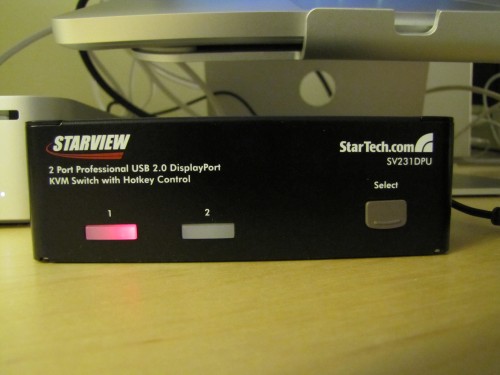
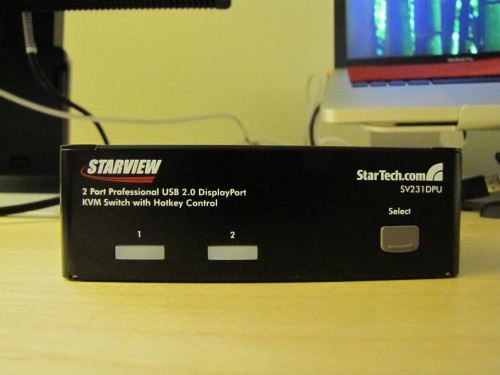
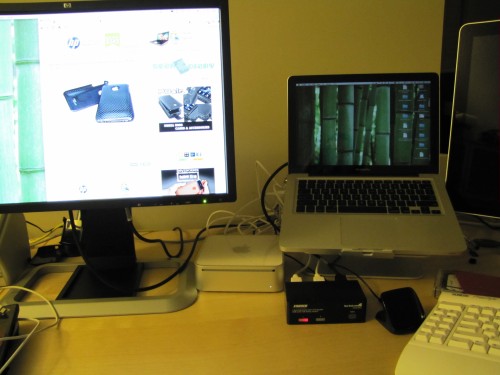
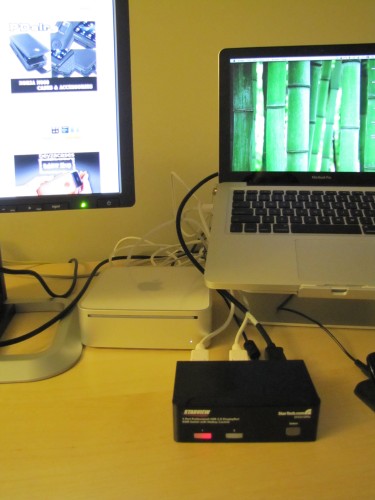
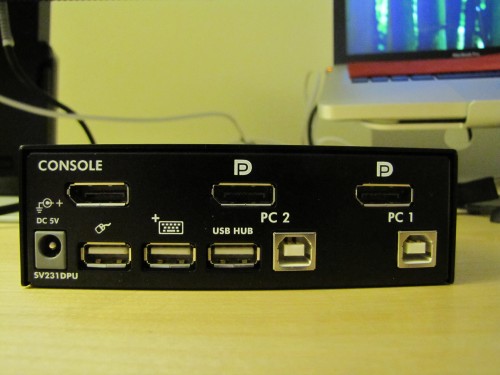
Thanks for the review. I’m thinking of getting the dual view version of this KVM switch. Would be grateful if you could share what keyboard and mouse you used, as I’m using the MX5500 wireless desktop. Regards.